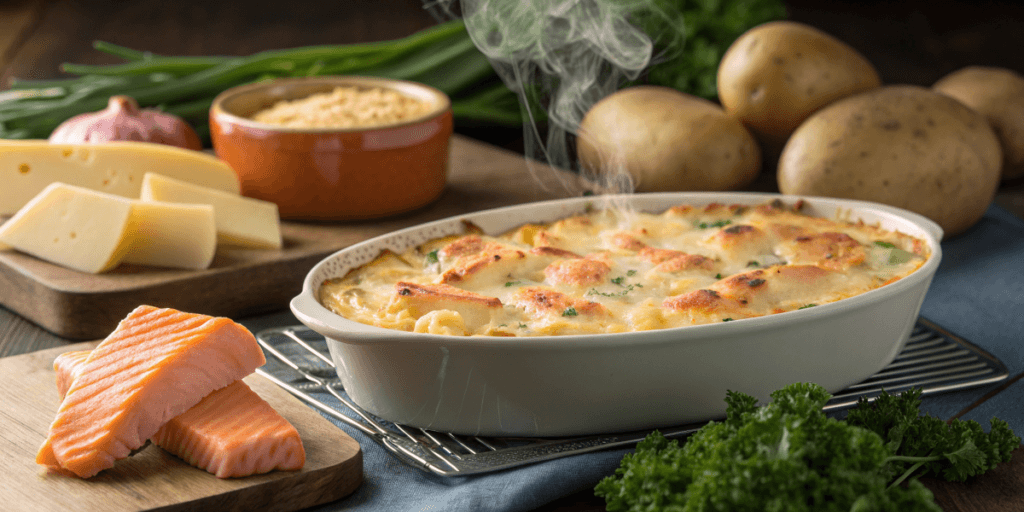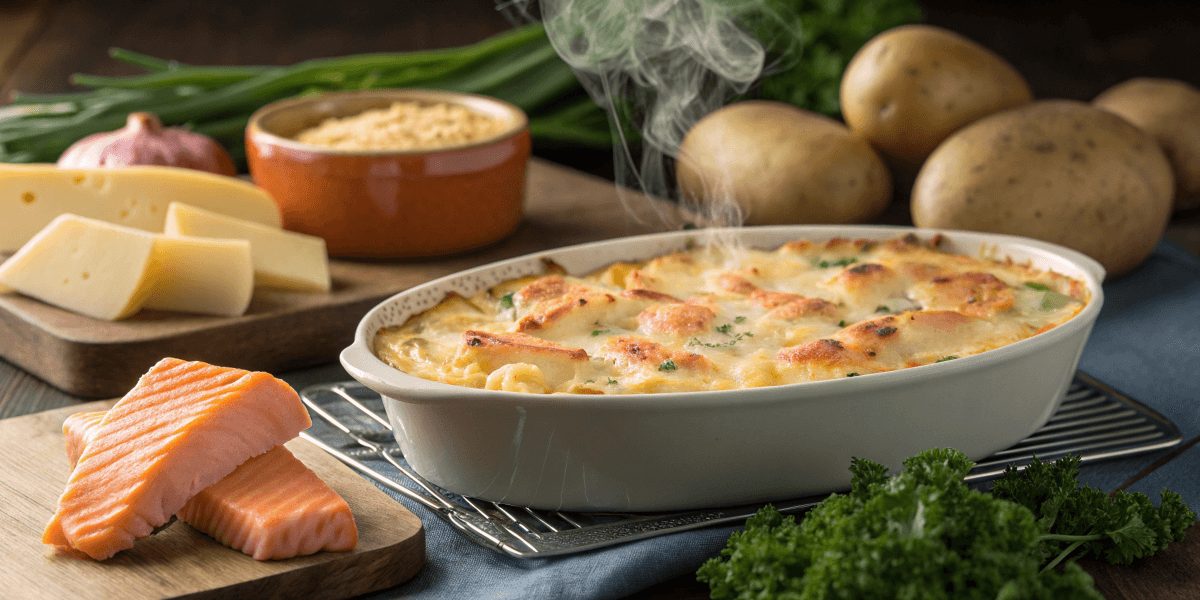Key Ingredients to Use in Casseroles with Salmon Fillets
Vegetables for a Casserole That Pairs Well with Salmon Fillets
Vegetables play a critical role in creating a casserole that pairs well with salmon fillets. They add flavor, texture, and balance to the dish. For instance, zucchini is a popular choice because its mild flavor doesn’t overpower the salmon. Similarly, spinach adds a vibrant green hue and a nutrient boost, making it both visually appealing and healthy.
Moreover, roasted red peppers can bring a sweet, smoky note to the casserole, which enhances the natural richness of the fish. For those who prefer a more substantial bite, broccoli and cauliflower work beautifully. They absorb the creamy sauces often used in casseroles, blending seamlessly with the tender salmon fillets. By combining a variety of vegetables, you can create a colorful, nutrient-packed dish that pairs perfectly with salmon.
Cheeses and Creamy Sauces for a Casserole That Pairs Well with Salmon Fillets
Creamy sauces and cheeses are essential for a comforting casserole that pairs well with salmon fillets. Cheddar and Parmesan are popular choices, offering a tangy, savory depth that complements the fish. Additionally, cream cheese or sour cream can create a velvety sauce, binding the ingredients together beautifully.
To elevate the dish further, consider using a béchamel or a light dill-infused cream sauce. These not only enhance the casserole’s richness but also add subtle, complementary flavors to the salmon. Transitioning from traditional dairy options, non-dairy alternatives like cashew cream can work equally well, ensuring the casserole meets dietary preferences.
Grains and Starches for a Casserole That Pairs Well with Salmon Fillets
Grains and starches provide a hearty foundation for a casserole that pairs well with salmon fillets. Wild rice, for instance, introduces a nutty flavor and chewy texture, creating an excellent contrast to the tender fish. Similarly, quinoa, known for its protein content, is a great gluten-free alternative that holds up well in baked dishes.
For a classic comfort food option, potatoes are a timeless choice. Whether sliced into layers or mashed into a creamy base, they add substance and soak up the casserole’s flavors effortlessly. Including grains or starches ensures the dish is filling and versatile enough to serve as a complete meal.
The Best Casserole Recipes for Salmon Fillets

Recipe 1: Creamy Cauliflower Casserole That Pairs Well with Salmon Fillets
This casserole that pairs well with salmon fillets features a creamy cauliflower base and tender salmon pieces. Begin by steaming cauliflower until soft, then blending it into a creamy puree with a touch of garlic and Parmesan. Layer the puree with chunks of seasoned salmon and sprinkle with breadcrumbs for a crispy topping. Bake until golden, and you’ll have a comforting dish perfect for any occasion.
Recipe 2: Diet-Friendly Ingredients for a Casserole That Pairs Well with Salmon Fillets
If you’re looking for a rustic casserole, this wild rice and mushroom option is an excellent choice. Start by cooking wild rice until tender, then mix it with sautéed mushrooms, onions, and a light cream sauce. Add flaked salmon fillets and bake until bubbly. The earthy mushrooms and nutty wild rice create a delightful pairing with the salmon’s rich flavor.
Recipe 3: Using Seasonal Ingredients in a Casserole That Pairs Well with Salmon Fillets
For those who crave cheesy goodness, this potato and dill casserole is ideal. Thinly slice potatoes and layer them in a baking dish, alternating with shredded salmon and a creamy dill sauce. Top with a generous layer of cheese—such as Gruyère or sharp cheddar—and bake until the top is golden and bubbling. The result is a decadent dish that pairs exceptionally well with salmon fillets.
Recipe 4: Mediterranean-Style Vegetable and Salmon Casserole
This Mediterranean-inspired recipe combines vibrant vegetables with perfectly cooked salmon fillets. Include ingredients like zucchini, eggplant, tomatoes, and Kalamata olives for a burst of color and flavor. A light drizzle of olive oil and a sprinkle of feta cheese complete the dish. This casserole not only highlights the salmon but also brings a refreshing Mediterranean twist to your meal.
Recipe 5: Zucchini and Parmesan Salmon Casserole
For a lighter yet equally delicious option, try a zucchini and Parmesan casserole. Slice zucchini into thin rounds and layer them with salmon pieces in a baking dish. Combine eggs, Parmesan cheese, and a dash of cream for a custard-like mixture to pour over the layers. Bake until set and slightly browned on top. This dish is perfect for showcasing salmon’s delicate flavor while keeping the meal light and fresh.
Relevant internal linking opportunities were identified, such as articles on “White Salmon” and “Exploring the Wonders of Salmon Belly.” These can be referenced for readers interested in learning more about salmon-related recipes. Here are Parts 4 and 5 of the article:
How to Customize Casseroles to Fit Your Tastes and Diets
Substituting Ingredients for Special Diets: Gluten-Free, Dairy-Free, and Keto Options
One of the best things about a casserole that pairs well with salmon fillets is its adaptability to various dietary needs. For those following a gluten-free diet, replacing breadcrumbs with almond meal or gluten-free crackers provides the same crunch without the gluten. Dairy-free eaters can substitute traditional cream sauces with coconut milk or cashew cream for a silky texture.
If you’re following a keto lifestyle, reducing high-carb ingredients like potatoes or rice is key. Replace them with low-carb vegetables such as zucchini, cauliflower, or spinach. These tweaks allow you to enjoy a delicious salmon casserole without compromising your diet, ensuring everyone at the table is satisfied.
Seasonal Ingredients to Elevate Your Salmon Casserole
Adding seasonal ingredients is a fantastic way to make your casserole fresh and flavorful. In spring, bright options like asparagus and peas enhance the dish’s lightness, while summer calls for vibrant zucchini or tomatoes. For fall and winter, incorporate heartier choices like butternut squash or sweet potatoes, which pair beautifully with the richness of salmon.
By using what’s in season, you not only elevate the taste of your casserole but also support local produce. This simple touch can turn a basic recipe into a standout dish that complements salmon fillets in every bite.
Common Challenges and Mistakes to Avoid
Avoiding Overcooking the Salmon
When making a casserole that pairs well with salmon fillets, overcooking the fish is a common mistake. Overcooked salmon becomes dry and loses its tender texture, which is key to the dish. To prevent this, add the salmon fillets later in the baking process or cook them separately before combining them with the casserole. This ensures your salmon remains moist and flavorful.
Balancing Flavors and Textures for the Perfect Bite
Another common challenge is achieving the right balance of flavors and textures. Using too much of one strong ingredient, such as garlic or cheese, can overpower the salmon’s delicate flavor. Instead, aim for a harmony of creamy, savory, and fresh elements in your casserole. Similarly, incorporating a mix of soft and crunchy textures keeps the dish interesting and satisfying.
Preventing a Watery or Dry Casserole
Maintaining the right consistency in your casserole is essential. Too much liquid can make the dish watery, while too little can leave it dry. To avoid these issues, use thickening agents like flour or cornstarch in your sauces. Additionally, pre-cook high-moisture vegetables like zucchini or mushrooms to reduce the water content they release during baking.
For more salmon-focused recipes, check out Exploring the Wonders of Salmon Belly or White Salmon Recipe Ideas. These articles offer additional ways to highlight salmon’s versatility in your meals.
FAQs
Can I Use Canned Salmon Instead of Fresh Salmon for Casseroles?
Yes, canned salmon can be a great option for creating a casserole that pairs well with salmon fillets. It is both affordable and convenient, making it a good choice for quick meals. However, fresh salmon offers a richer flavor and a firmer texture, which elevates the overall dish. If using canned salmon, make sure to drain it well and remove any skin or bones before adding it to your casserole. Combining canned salmon with fresh ingredients like vegetables and herbs can help enhance the dish.
What Are the Best Side Dishes to Serve with Salmon Casseroles?
Even though a salmon casserole is often a complete meal, pairing it with the right side dishes can make it even more enjoyable. For a lighter option, consider a crisp green salad with a zesty lemon vinaigrette. If you want something heartier, roasted asparagus or garlic bread are excellent choices. These sides balance the flavors of the casserole without overpowering the salmon.
For those who enjoy contrasting textures, a crunchy slaw or pickled vegetables can add an extra layer of complexity. These options make your casserole feel more like a feast, especially when serving guests.
How Do I Store and Reheat Salmon Casseroles?
Storing a casserole that pairs well with salmon fillets is simple. First, let the dish cool completely before transferring it to an airtight container. It can be stored in the refrigerator for up to three days or frozen for longer storage. When reheating, use an oven rather than a microwave to prevent the salmon from drying out. Cover the casserole with foil while reheating to maintain its moisture. For the best results, reheat individual portions to ensure even warming.
What Are the Best Herbs to Use in Salmon Casseroles?
Herbs play a significant role in enhancing the flavor of a casserole that pairs well with salmon fillets. Dill is a classic choice, as its fresh, slightly sweet flavor complements salmon beautifully. Parsley and thyme are also excellent options for adding subtle, earthy notes. If you’re looking for a more unique twist, try using tarragon or fennel fronds for their slightly anise-like taste. Fresh herbs work best, but dried versions can also be used when fresh is unavailable.
Conclusion:
Salmon’s Unique Taste and Its Role in a Balanced Casserole
Salmon’s rich, buttery flavor and tender texture make it a perfect protein for casseroles. When combined with complementary ingredients like creamy sauces, vegetables, and grains, it creates a satisfying and balanced dish. A casserole that pairs well with salmon fillets is more than just a meal—it’s a showcase of flavors and textures that come together harmoniously. Whether you’re using fresh or canned salmon, the results are always delicious.
Other Ideas for Pairing Salmon with Comfort Foods
If you’re looking for more ways to enjoy salmon beyond casseroles, consider pairing it with other comfort foods. For example, a salmon pot pie or a hearty salmon chowder can offer a similar blend of warmth and satisfaction. These dishes highlight salmon’s versatility and make it easy to incorporate this nutritious fish into your weekly menu. With so many options, salmon can remain a staple ingredient in countless comforting and creative recipes.
Creative Variations for Casseroles with Salmon Fillets
Turning Classic Dishes into a Casserole That Pairs Well with Salmon Fillets
Transforming classic dishes into a casserole that pairs well with salmon fillets is a fun way to experiment in the kitchen. For instance, you can take the flavors of a traditional salmon en papillote—using lemon, dill, and vegetables—and layer them into a creamy potato-based casserole. Similarly, adapt the elements of a salmon Alfredo pasta into a baked dish by combining cooked pasta, salmon, a rich Alfredo sauce, and a breadcrumb topping.
Another creative approach is drawing inspiration from global cuisines. Consider making a salmon curry casserole with coconut milk, mild curry spices, and a rice base. These creative twists make casseroles exciting while still highlighting the delicate flavor of salmon.
Using Leftovers to Create New Salmon Casserole Recipes
Casseroles are an excellent way to repurpose leftovers, and salmon is no exception. If you have cooked salmon from a previous meal, flake it into smaller pieces and mix it into a casserole. Leftover roasted vegetables, rice, or mashed potatoes can also be incorporated, reducing food waste while creating a new dish. Adding fresh herbs and a simple cheese or cream topping can elevate these leftovers into something that feels entirely new.
Additionally, canned salmon can serve as a pantry-friendly backup option for times when you don’t have fresh fish on hand. These adaptable methods make it easier to create a casserole that pairs well with salmon fillets, even with limited ingredients.
How to Present Your Salmon Casserole for Maximum Appeal
Plating Tips to Enhance the Appearance of Your Casserole
Presentation plays a big role in the dining experience, even for casseroles. To make your dish look more appetizing, start by baking it in an attractive, oven-safe dish that can go directly from the oven to the table. Once baked, garnish the casserole with fresh herbs like parsley or dill for a pop of color.
For individual servings, use a spatula to scoop neat portions and arrange them on plates with complementary sides. Adding a wedge of lemon or a drizzle of olive oil can further brighten the plate, making your casserole that pairs well with salmon fillets visually appealing as well as delicious.
Pairing Drinks and Sides for the Ultimate Meal
Pairing your salmon casserole with the right drinks and sides can turn a simple dinner into an elegant meal. For drinks, a light, crisp white wine like Sauvignon Blanc complements the richness of the casserole without overpowering the salmon’s flavor. If you prefer non-alcoholic options, try sparkling water with a splash of citrus or a chilled herbal tea.
As for sides, fresh salads with lemon-based dressings or roasted green vegetables like asparagus or Brussels sprouts make excellent companions. These lighter sides balance the creamy richness of the casserole, ensuring the meal feels satisfying but not too heavy.

